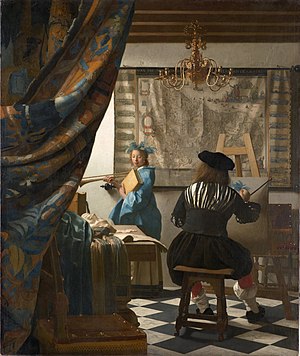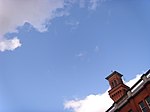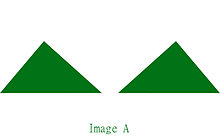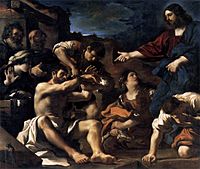In Art Is the Structure Organization or Total Form of a Work

The term composition ways "putting together". It can be idea of every bit the organization of the elements of art according to the principles of art. Composition can employ to whatsoever piece of work of art, from music through writing and into photography, that is bundled using conscious thought.
In the visual arts, composition is frequently used interchangeably with various terms such as design, form, visual ordering, or formal structure, depending on the context. In graphic design for press and desktop publishing, limerick is normally referred to as page layout.
The composition of a picture is different from its subject (what is depicted), whether a moment from a story, a person or a identify. Many subjects, for example Saint George and the Dragon, are oftentimes portrayed in art, but using a groovy range of compositions fifty-fifty though the two figures are typically the but ones shown.
Elements of design [edit]
The primal visual element, known as element of blueprint, formal element, or element of art, establish the vocabulary with which the visual artist compose. These elements in the overall design usually relate to each other and to the whole art piece of work.
The elements of design are:
- Line — the visual path that enables the eye to motion within the slice
- Shape — areas defined by edges within the piece, whether geometric or organic
- Color — hues with their various values and intensities
- Texture — surface qualities which translate into tactile illusions
- Value — Shading used to emphasize form
- Form — three-D length, width, or depth
- Space — the space taken upwards past (positive) or in between (negative) objects
Line and shape [edit]

Lines are optical phenomena that allow the artist to direct the eye of the viewer. The optical illusion of lines do exist in nature, and visual arts elements can be bundled to create this illusion. The viewer unconsciously reads nigh the continuous arrangement of different elements and subjects at varying distances. Such elements can be of dramatic use in the composition of the image. These could exist literal lines such as telephone and power cables or rigging on boats. Lines can also derive from the borders of different colors or contrast or sequences of discrete elements. Motion is besides a source of lines, where the blurred movement renders every bit a line.[1]
Field of study lines contribute to both mood and linear perspective, giving the viewer the illusion of depth. Oblique lines convey a sense of motility, and angular lines generally convey dynamism and possibly tension. Lines can likewise direct attention towards the main subject of the picture or contribute to the arrangement past dividing it into compartments. The creative person may exaggerate or create lines, maybe as role of their message to the viewer. Many lines without a clear subject bespeak suggest anarchy in the image and may conflict with the mood the artist is trying to evoke.[ citation needed ]
A line'southward angle and its human relationship to the frame's size influence the perspective of the image. Horizontal lines, commonly institute in landscape photography, can give the impression of calm, serenity, and space. An image filled with strong vertical lines tends to have the appearance of height and grandeur. Tightly angled convergent lines give a dynamic, lively, and active event to the image. Firmly turned, almost diagonal lines produce tension in the motion picture. The viewpoint of visual fine art is central considering every different perspective views different angled lines. This alter of perspective elicits a different response to the image. Changing the air simply by some degrees or some centimeters lines in embodiments tin can vary tremendously, and a distinct feeling tin can be transported. Directly lines are likewise strongly influenced by tone, color, and repetition apropos the residuum of the prototype.
Compared to directly lines, curves provide a greater dynamic influence in a flick. They are too generally more aesthetically pleasing, every bit the viewer associates them with softness. In photography, curved lines can give graduated shadows when paired with soft-directional lighting, which usually results in a very harmonious line structure within the paradigm. There are 2 main types of curves, a simple "C" curve as well as a more than sinuous "S" curve.[2]
Color [edit]
In that location are three properties of colour: hue, effulgence or chroma, and value. Hue is the proper noun of a colour (red, yellow, and blue, etc.). Brightness and blush refer to the intensity and strength of the color. A loftier blush color is more pure and less greyed than a low chroma color. The lightness or darkness to a color is the value. Color as well has the ability to work inside our emotions. Given that, nosotros can use color to create mood. It tin as well exist used equally tone, pattern, light, movement, symbol, form, harmony, and contrast.[3] [four]
Texture [edit]
Texture refers to how an object feels or how it looks like it may feel if it were touched. In that location are two means nosotros experience texture, physically and optically. Dissimilar techniques can be used to create physical texture, which allows qualities of visual art to exist seen and felt. This can include surfaces such as metal, sand, and wood. Optical texture is when the illusion of physical texture is created. Photography, paintings, and drawings employ visual texture to create a more realistic appearance.[five]
Value [edit]
Lightness and darkness are known as value in visual art. Value deals with how light reflects off objects and how we see it. The more light that is reflected, the higher the value. White is the highest or lightest value while black is the lowest or darkest value. Colors also have value; for example, yellow has a loftier value while blue and red have a low value. If you have a black and white picture of a colorful scene, all you are left with are the values. This of import element of blueprint, especially in painting and cartoon, allows the artist to create the illusion of light through value contrast.[six]
Form [edit]
The term form can mean different things in visual fine art. Course suggests a three-dimensional object in space. It is besides described as the physical nature of the artwork, such as sculptures. It tin also be looked at every bit fine art course, which can be expressed through fine fine art. A grade encloses volume, has length, width, and height, unlike a shape, which is only two-dimensional. Forms that are mathematical, a sphere, pyramid, cube, cylinder, and cone, are known as geometric forms. Organic forms are typically irregular and asymmetrical. This form tin can be establish in nature, such equally flowers, rocks, copse, etc., just can also be seen in architecture.[7]
Forms in drawing and painting convey the illusion of iii-dimensional form through lighting, shadows, value, and tone. The more contrast in value, the more than pronounced the three-dimensional form is. Forms with fiddling value appear flatter than those with greater variation and contrasting.
Space [edit]
Space is the expanse effectually, to a higher place, and inside an object. Photographers can capture infinite, architects build space, and painters create space. This chemical element is found in each of the visual arts. It can be positive or negative, open up or closed, shallow or deep, and two-dimensional or three-dimensional. In cartoon or painting, space is not actually there, but the illusion of it is. Positive space is the field of study of the piece. The empty spaces effectually, in a higher place, and within, is negative infinite.[viii] [nine]
Principles of organisation [edit]
The artist determines what the middle of interest (focus in photography) of the art work will exist, and composes the elements appropriately. The gaze of the viewer will then tend to linger over these points of interest, elements are bundled with consideration of several factors (known variously as the principles of organization, principles of art, or principles of design) into a harmonious whole which works together to produce the desired statement – a phenomenon commonly referred to every bit unity. Such factors in limerick should not be confused with the elements of art (or elements of pattern) themselves. For instance, shape is an chemical element; the usage of shape is characterized by diverse principles.
Some principles of system affecting the composition of a picture are:
- Shape and proportion
- Positioning/orientation/remainder/harmony among the elements
- The area within the field of view used for the picture ("cropping")
- The path or direction followed by the viewer's center when they discover the prototype.
- Negative space
- Color
- Dissimilarity: the value, or degree of lightness and darkness, used within the picture.
- Organization: for example, use of the golden mean or the rule of thirds
- Lines
- Rhythm
- Illumination or lighting
- Repetition (sometimes building into design; rhythm also comes into play, every bit does geometry)
- Perspective
- Breaking the rules can create tension or unease, all the same it can add interest to the picture show if used carefully
Viewpoint (leading with the eye) [edit]
The position of the viewer tin can strongly influence the aesthetics of an epitome, fifty-fifty if the bailiwick is entirely imaginary and viewed "inside the mind's heart". Not just does it influence the elements within the picture, but information technology as well influences the viewer'southward estimation of the field of study.
For example, if a boy is photographed from in a higher place, perhaps from the heart level of an developed, he is diminished in stature. A photo taken at the child'south level would treat him every bit an equal, and one taken from below could upshot in an impression of authority. Therefore, the lensman is choosing the viewer's positioning.
A subject can be rendered more dramatic when it fills the frame. In that location exists a trend to perceive things as larger than they actually are, and filling the frame fulfills this psychological mechanism. This can be used to eliminate distractions from the background.
In photography, altering the position of the photographic camera can change the image so that the discipline has fewer or more distractions with which to compete. This may be achieved by getting closer, moving laterally, tilting, panning, or moving the camera vertically.
Compositional techniques [edit]
There are numerous approaches or "compositional techniques" to achieve a sense of unity inside an artwork, depending on the goals of the artist. For example, a work of art is said to be aesthetically pleasing to the centre if the elements within the piece of work are arranged in a balanced compositional style.[10] Nevertheless, there are artists such every bit Salvador Dalí who aim to disrupt traditional composition and challenge the viewer to rethink residual and design elements within art works.
Conventional limerick can be achieved with a number of techniques:
Rule of thirds [edit]
The rule of thirds is a composition guide that states that arranging the important features of an image on or near the horizontal and vertical lines that would divide the prototype into thirds horizontally and vertically is visually pleasing. The objective is to terminate the subjects and areas of involvement (such as the horizon) from bisecting the image, by placing them near 1 of the lines that would carve up the paradigm into three equal columns and rows, ideally near the intersection of those lines.

Rule of thirds: Notation how the horizon falls close to the bottom grid line, and how the night areas are in the left tertiary, the overexposed in the right third.
The rule of thirds is thought to be a simplification of the golden ratio. The gilded ratio is thought to have been used past artists throughout history as a composition guide, but there is little testify to support this claim.
Rule of odds [edit]
The "rule of odds" suggests that an odd number of subjects in an prototype is more interesting than an fifty-fifty number. Thus if you take more than one subject in your picture, the suggestion is to choose an arrangement with at least 3 subjects. An even number of subjects produces symmetries in the image, which can appear less natural for a naturalistic, informal composition.
An image of a person surrounded/framed past two other persons, for instance, where the person in the centre is the object of interest in that image/artwork, is more likely to be perceived equally friendly and comforting by the viewer, than an image of a single person with no significant environs.
Dominion of infinite [edit]

Image of a racing car with lead room
The rule of infinite applies to artwork (photography, advertizing, illustration) picturing objects to which the creative person wants to utilise the illusion of movement, or which is supposed to create a contextual bubble in the viewer'due south heed.
This can be achieved, for instance, by leaving white space in the direction the eyes of a portrayed person are looking, or, when picturing a runner, adding white space in forepart of him rather than backside him to indicate motion.
Simplification [edit]
Images with clutter can distract from the main elements inside the motion-picture show and brand information technology difficult to identify the subject. By decreasing the extraneous content, the viewer is more likely to focus on the primary objects. Clutter tin can also be reduced through the use of lighting, every bit the brighter areas of the image tend to describe the eye, as do lines, squares and colour. In painting, the creative person may apply less detailed and defined brushwork towards the edges of the picture. Removing the elements to the focus of the object, taking but the needed components.
Shallow depth of field [edit]
In photography, and besides (via software simulation of existent lens limitations) in 3D graphics, one approach to achieving simplification is to utilise a wide aperture when shooting to limit the depth of field. When used properly in the right setting, this technique can place everything that is not the subject of the photograph out of focus.
| The blurred groundwork focuses the eye on the flowers. | At a smaller aperture, the background competes for the viewer's attention. |
A similar approach, given the right equipment, is to take reward of the Scheimpflug principle to modify the aeroplane of focus.
Geometry and symmetry [edit]

A unproblematic composition with deject and rooftop that creates asymmetry.
Related to the rule of odds is the observation that triangles are an aesthetically pleasing unsaid shape inside an paradigm. In a canonically attractive confront, the oral cavity and eyes fall within the corners of the area of an equilateral triangle.[ commendation needed ] Paul Cézanne successfully used triangles in his compositions of still lifes. A triangular format creates a sense of stability and strength.
Creating motion [edit]
It is generally idea to exist more than pleasing to the viewer if the epitome encourages the centre to motion effectually the paradigm, rather than immediately fixating on a unmarried place or no place in particular. Artists volition often strive to avert creating compositions that feel "static" or "flat" by incorporating movement into the paradigm. In image A the two mountains are as sized and positioned beside each other creating a very static and uninteresting image. In paradigm B the mountains are differently sized and one is placed closer to the horizon, guiding the eye to move from one mountain to the other creating a more interesting and pleasing image. This also feels more natural because in nature objects are rarely the aforementioned size and evenly spaced.


Other techniques [edit]
- At that place should be a center of interest or focus in the work, to prevent it condign a pattern in itself
- The direction followed by the viewer's eye should lead the viewer'south gaze effectually all elements in the work before leading out of the picture
- The subject should not exist facing out of the image
- Exact bisections of the picture space should be avoided
- Minor, high contrast, elements have equally much touch as larger, duller elements
- The prominent subject should be off-centre, unless a symmetrical or formal composition is desired, and tin be balanced by smaller satellite elements
- The horizon line should non divide the art work in ii equal parts merely be positioned to emphasize either the heaven or basis; showing more than sky if painting is of clouds, sun ascent/gear up, and more than footing if a mural
- Utilise of detailed areas and 'rest' areas can help to aid the middle in where to look. Creating a contrast between detail and lack of item is important
These principles tin exist means of a adept composition even so they cannot exist applied separately but should human action together to class a good composition.
- As well in an artwork, information technology is suggested that no spaces between the objects should be the same to create a more interesting image.
Example [edit]
These paintings all show the same subject, the Raising of Lazarus, and essentially the aforementioned figures, merely have very different compositions:
Come across also [edit]
- Miksang (contemplative photography)
- New Epoch Notation Painting (a notation organization for painting)
- Folio layout (graphic design)
- CLACL (a computer linguistic communication for composition)
- Listing of photographic composition techniques
References [edit]
- ^ Wrigley, Alex. "How to Utilize Leading Lines in Your Photography Composition". Click and Acquire Photography . Retrieved six February 2019.
- ^ Taylor, David (21 February 2015). Agreement Composition: The Expanded Guide. Due east Sussex: Ammonite Press. p. 68. ISBN9781781451083.
- ^ Esaak, Shelley. "What is the Definition of Color in Art?". ThoughtCo . Retrieved March 8, 2017.
- ^ "Element of Design: Color". Art Foundations. Archived from the original on 2018-12-23. Retrieved 2018-04-03 .
- ^ "The Visual Elements". Artyfactory.
- ^ Fussell, Matt. "The Elements of Fine art-"Value"". The Virtual Instructor.
- ^ Marder, Lisa. "What Does the Term 'Form' Mean in Regards to Art?". ThoughtCo . Retrieved January 23, 2018.
- ^ Esaak, Shelley. "Exploring the Spaces Betwixt and Within Usa". ThoughtCo . Retrieved February 19, 2018.
- ^ "What is Infinite?". Sophia. Sophia Learning.
- ^ Dunstan, Bernard. (1979). Composing Your Paintings. London, Studio Vista.
Further reading [edit]
- Arnheim, Rudolf (1974). Art and Visual Perception: A Psychology of the Artistic Eye. University of California Printing. ISBN978-0-520-02613-i.
- Downer, Marion (1947). Discovering Design. Lothrop Lee & Shepard. ISBN0-688-41266-one.
- Graham, Peter (2004). An Introduction to Painting Withal Life . Chartwell Books Inc. ISBN0-7858-1750-half dozen.
- Grill, Tom; Scanlon, Mark (1990). Photographic Composition. Watson-Guptill Publications. ISBN0-8174-5427-6.
- Peterson, Bryan (1988). Learning to See Creatively . Watson-Guptill Publications. ISBN0-8174-4177-8.
- Langford, Michael (1982). The Master Guide to Photography. New York: Dorling Kindersley Express. ISBN0-394-50873-four.
External links [edit]
- Percy Principles of Art and Composition, Goshen College Art Department
- Using Particular and why it is important
Source: https://en.wikipedia.org/wiki/Composition_%28visual_arts%29






0 Response to "In Art Is the Structure Organization or Total Form of a Work"
Post a Comment